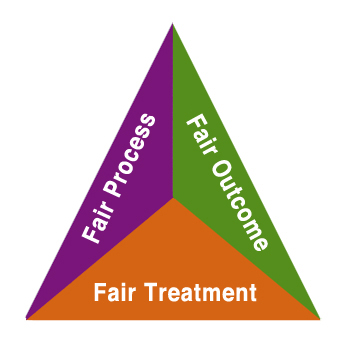Fairness Triangle
The Fairness Triangle outlines three dimensions of fairness to be considered in an individual’s experience: Relational, Procedural and Substantive. It can be a helpful tool to consider in the decision-making process.
Relational Fairness addresses how one is treated.
- Being approachable;
- Listening actively;
- Respecting confidentiality;
- Being honest and forthright;
- Making information clear and easily available;
- Providing accessible problem-solving options;
- Being clear about what you can and cannot do; and
- Offering an apology if a mistake is made.
Substantive Fairness addresses the decision itself.
- Having the appropriate authority to make the decision itself;
- Ensuring that decisions are made on relevant information;
- Ensuring that decisions are not unjust, oppressive or discriminatory;
- Ensuring that decisions are not wrong in fact or law; and
- Ensuring that decisions are reasonable.
Procedural Fairness addresses processes used in making the decision.
- Providing notice that a decision is to be made along with sufficient information for an affected person to know what is required and what is at stake;
- Providing an appropriate forum for an affected person to present their views and to be heard;
- Being impartial and unbiased;
- Making a decision in a reasonable time; and
- Providing clear and appropriate reasons for a decision.
The Fairness Triangle was initially developed by Ombudsman Saskatchewan and adapted by the University of Victoria Ombudsperson. It is meant to be a tool to guide decision-making and is not university policy. It is also important to note that fairness does not necessarily equate to an outcome in your favor.

